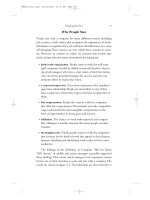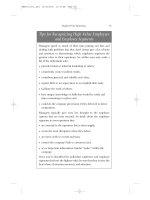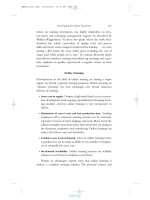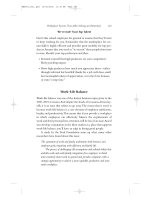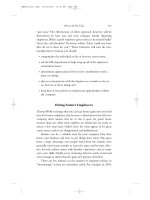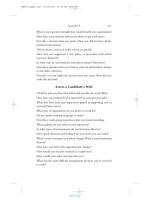Hiring and Keeping the Best People 14
Bạn đang xem bản rút gọn của tài liệu. Xem và tải ngay bản đầy đủ của tài liệu tại đây (108.3 KB, 8 trang )
Market-Wise Retention 91
Managers spend so much of their time putting out fires and
dealing with problems that they don’t always give a lot of time
and attention to determining which employees represent the
greatest value to their operations. So, within your unit, make a
list of the individuals who:
•
provide formal or informal leadership to others,
•
consistently create excellent results,
•
contribute practical and valuable new ideas,
•
require little or no supervision to accomplish their tasks,
•
facilitate the work of others,
•
have unique knowledge or skills that would be costly and
time-consuming to replace, and
•
could do the company great harm if they defected to direct
competitors.
Managers typically give even less thought to the employee
segments that are most essential. So think about the employee
segments in your operation that:
•
are essential to the operation but in short supply,
•
create the most disruption when they defect,
•
are most costly to recruit and train,
•
control the company’s link to customers and,
•
act as important information transfer “nodes” within the
company.
Once you’ve identified the individual employees and employee
segments that have the highest value, be sure that they receive the
lion’s share of retention resources and attention.
Tips for Recognizing High-Value Employees
and Employee Segments
HBE001_ch4_.qxd 10/02/2002 11:34 AM Page 91
UPS in this instance was less concerned with its overall reten-
tion rate than with the retention of particular people who were
costly to replace and who added substantial value through their
direct interface with customers. It identified a key employee
segment and took an active step in retaining them, even though that
action would make retention of a less-valued segment more
difficult.
Now ask yourself:
•
Which are my company’s (unit’s) most valuable employee
segments? (See “Tips for Recognizing High-Value Employees
and Employee Segments.”)
•
Which employee segments are least valuable and/or easily
replaced and trained?
•
How are our current retention efforts allocated with respect to
these very different segments?
No company has an entirely free hand in how and to what
degree it can allocate its retention efforts. Dramatic compensation
differences between individual employees may create friction and
resentment between people who must work together. Labor agree-
ment and government regulations likewise stand in the way of some
market-based approaches. Qualified retirement plan statutes, for
example, do not tolerate differences in the terms of plan participa-
tion or percentage-of-compensation contributions. Nevertheless,
there are strategies for keeping the best or, at a minimum, keeping
them longer.We turn to these next.
Market-Based Retention Strategies
Cappelli suggests a number of practical retention strategies that rec-
ognize labor market realties and value-differences between employee
segments: new compensation plans, job redesign, job customization,
strengthening social ties,and hiring the less mobile. Linking potential
defectors with internal job opportunities is another market-wise tool
for retention.
92 Hiring and Keeping the Best People
HBE001_ch4_.qxd 10/02/2002 11:34 AM Page 92
New Compensation Plans
Most people in the know give compensation a low rating as a reten-
tion strategy. Compensation matters in the sense that you cannot
recruit or retain desirable employees if they view their compensation
as unfair or noncompetitive. Even people who are more dedicated
to their crafts or professions than to money see their compensation
as an indication of the organization’s appreciation of their contribu-
tions and abilities. If they feel undervalued, they will walk. (See “Tips
for Getting Compensation Right.”)
Nor is compensation a reliable motivator. Years ago, Frederick
Herzberg, the tribal elder of motivation, found that the incentives
employers most commonly use to motivate—including pay raises—
produce temporary performance improvements at best.
4
We need only look to the “retention champions” profiled in the
previous chapter to appreciate the limited utility of compensation as
a motivational and retention tool. Southwest Airlines is near the bot-
tom of the list in terms of entry-level pay within its industry (though
pay relative to its competitors improves with longevity). Never-
theless, SWA employees are highly motivated to deliver on the air-
line’s strategy, and defect at half the rate of the airline industry as a
whole. Meanwhile, SAS Institute, the software company, experiences
approximately one-quarter the turnover rate of its industry even
though its pay scales are no higher than those of competing compa-
nies. And unlike workers in most other high-tech companies, SAS
people do not receive stock options.
SWA and SAS are not unique cases.The limited value of pay as
a retention tool is corroborated by various studies. Typical of these is
a 1999 American Management Association/Ernst & Young work-
place survey, which ranked compensation low on the scale relative to
most other employee-retention factors.
5
Clearly, other strategies
have greater impact on retention.
Peter Cappelli offers these pieces of advice for market-wise
compensation:
6
•
Pay “hot skills” premiums to employees with crucial, rare
expertise.This keeps them in place for critical periods—for
Market-Wise Retention 93
HBE001_ch4_.qxd 10/02/2002 11:34 AM Page 93
example, the late design stages of a key product. Stop premiums
when the skills become more available or less important to
your business.
•
Pay signing bonuses in stages—for example, pay out the new
CEO’s sign-on bonus over five years.
Job Redesign
Job redesign is another retention strategy, as the UPS example men-
tioned earlier makes clear. If you can identify the elements that cre-
ate satisfaction and dissatisfaction within a particular job, you may be
able to split off the dissatisfying tasks entirely and give them to other
individuals who will appreciate the work. Outsourcing unwanted
tasks is another solution, and something that every company prac-
94 Hiring and Keeping the Best People
Compensation really matters. But as a retention issue, it’s one of
the easiest to address—much easier than organizational culture.
Here are some strategies for getting compensation right:
Figure out what wages your industry is offering.
You can
do this by hiring a compensation and benefits consulting
firm—or by trying these more affordable options:
• track classified ads on the Internet
•
network with members of human resources
organizations
•
consult trade organizations
Examine internal pay disparities.
Make sure that the pay
for each job is roughly equivalent to that of similar jobs
across the organization.
Don’t assume you have to outspend your competitors.
Just
make sure you can meet employees’ most important
Tips for Getting Compensation Right
HBE001_ch4_.qxd 10/02/2002 11:34 AM Page 94
tices to one extent or another. The big securities dealers on Wall
Street, for example, don’t ask their traders and clerical personnel to
clean out the restrooms and vacuum the carpets before they go
home at night. They outsource those tasks to commercial cleaning
companies.Your company does the same.
So, if you experience unacceptable turnover in key jobs that are
difficult and costly to refill,put each job under a microscope and ask:
• Which aspects of this job create employee dissatisfaction? (Ask
several employees directly.)
•
If we separated objectionable tasks from the job, would we
need to add something else to keep it a “whole” job? And what
would that something else be?
•
Assuming that someone must do the objectionable tasks, what
alternatives exist for handling them?
• Which is more costly to the organization, job redesign (and its
consequences) or the current rate of turnover in the key job?
Psychologists Timothy Butler and James Waldroop, directors of
M.B.A. career development programs at Harvard Business School,
have used the term “job sculpting” to describe their own form of job
design.
7
Their prescription is to design jobs that match the “deeply
embedded life interests”we identified earlier in this book (application
of technology, quantitative analysis, counseling and mentoring, etc.).
For instance, a competent engineer with a deeply embedded life
interest in counseling and mentoring might be asked to plan and
manage the orientation of newly hired engineers. A salesperson
with an interest in quantitative analysis might be given new duties
working with the firm’s market-research analysts.Effective job sculpt-
ing is only possible,however, when managers ask questions and listen
carefully to what their employees tell them about their real interests.
Job Customization
Companies have almost always tried to fit people to jobs.Their writ-
ten job descriptions and workplace routines itemize tasks and
Market-Wise Retention 95
HBE001_ch4_.qxd 10/02/2002 11:34 AM Page 95
